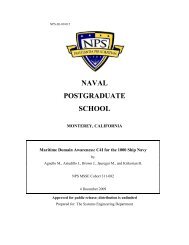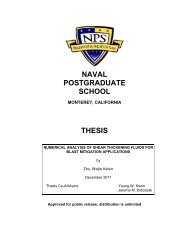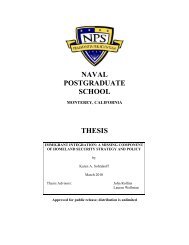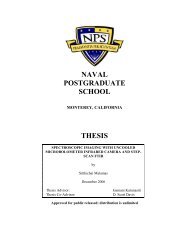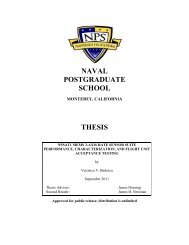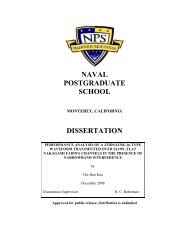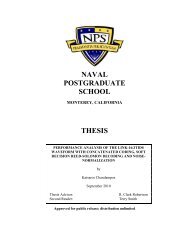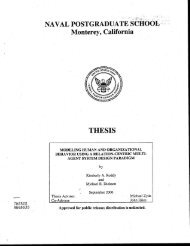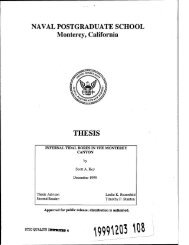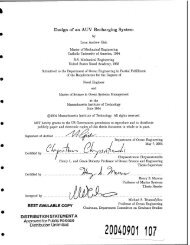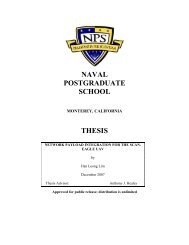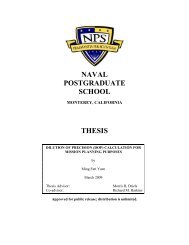A Solution to the Inherent List on Nimitz Class Aircraft Carriers
A Solution to the Inherent List on Nimitz Class Aircraft Carriers
A Solution to the Inherent List on Nimitz Class Aircraft Carriers
Create successful ePaper yourself
Turn your PDF publications into a flip-book with our unique Google optimized e-Paper software.
classified in<str<strong>on</strong>g>to</str<strong>on</strong>g> four status c<strong>on</strong>diti<strong>on</strong>s for vertical center of gravity (KG) and limiting drafts. As<br />
specified in [4], <str<strong>on</strong>g>the</str<strong>on</strong>g> definiti<strong>on</strong>s for <str<strong>on</strong>g>the</str<strong>on</strong>g> status listings are:<br />
• STATUS 1 An increase in weight and a rise of <str<strong>on</strong>g>the</str<strong>on</strong>g> ship's center of gravity are<br />
acceptable. Added weight and moment resulting from changes will not require any<br />
compensati<strong>on</strong> unless <str<strong>on</strong>g>the</str<strong>on</strong>g> magnitude of <str<strong>on</strong>g>the</str<strong>on</strong>g> additi<strong>on</strong>s is so large as <str<strong>on</strong>g>to</str<strong>on</strong>g> make <str<strong>on</strong>g>the</str<strong>on</strong>g> ship<br />
approach stability limits.<br />
• STATUS 2<br />
accepted.<br />
Nei<str<strong>on</strong>g>the</str<strong>on</strong>g>r an increase in weight nor a rise of a ship's center of gravity can be<br />
• STATUS 3 An increase in <str<strong>on</strong>g>the</str<strong>on</strong>g> ship's weight is acceptable, but a rise of <str<strong>on</strong>g>the</str<strong>on</strong>g> ship's center<br />
of gravity must be avoided.<br />
• STATUS 4 A rise of <str<strong>on</strong>g>the</str<strong>on</strong>g> ship's center of gravity is acceptable, but increase in weight<br />
must be avoided. Compensati<strong>on</strong> for added weight may be obtained by removal of an<br />
equal or greater weight at any level.<br />
Status 1 is <str<strong>on</strong>g>the</str<strong>on</strong>g> <strong>on</strong>ly acceptable ship status. The goal is for ships in <str<strong>on</strong>g>the</str<strong>on</strong>g> fleet <str<strong>on</strong>g>to</str<strong>on</strong>g> remain in<br />
Status 1. In <str<strong>on</strong>g>the</str<strong>on</strong>g> o<str<strong>on</strong>g>the</str<strong>on</strong>g>r three status c<strong>on</strong>diti<strong>on</strong>s, <str<strong>on</strong>g>the</str<strong>on</strong>g> displacement and KG must be closely<br />
m<strong>on</strong>i<str<strong>on</strong>g>to</str<strong>on</strong>g>red <str<strong>on</strong>g>to</str<strong>on</strong>g> ensure <str<strong>on</strong>g>the</str<strong>on</strong>g> c<strong>on</strong>diti<strong>on</strong> does not worsen and steps must be taken <str<strong>on</strong>g>to</str<strong>on</strong>g> try <str<strong>on</strong>g>to</str<strong>on</strong>g> bring <str<strong>on</strong>g>the</str<strong>on</strong>g><br />
ship back within acceptable design limits. Typically, when an in-service carrier requires a<br />
modificati<strong>on</strong> that will add weight <str<strong>on</strong>g>to</str<strong>on</strong>g> <str<strong>on</strong>g>the</str<strong>on</strong>g> ship, it is <str<strong>on</strong>g>the</str<strong>on</strong>g> resp<strong>on</strong>sibility of <str<strong>on</strong>g>the</str<strong>on</strong>g> program office and <str<strong>on</strong>g>the</str<strong>on</strong>g><br />
planning yard <str<strong>on</strong>g>to</str<strong>on</strong>g> put <str<strong>on</strong>g>to</str<strong>on</strong>g>ge<str<strong>on</strong>g>the</str<strong>on</strong>g>r a package that includes maintenance and repair items, as well as<br />
modernizati<strong>on</strong> changes. First, a preliminary weight estimate of <str<strong>on</strong>g>the</str<strong>on</strong>g> modernizati<strong>on</strong> changes are<br />
put <str<strong>on</strong>g>to</str<strong>on</strong>g>ge<str<strong>on</strong>g>the</str<strong>on</strong>g>r in <str<strong>on</strong>g>the</str<strong>on</strong>g> package and made ready for installati<strong>on</strong>. Once <str<strong>on</strong>g>the</str<strong>on</strong>g> package is installed, <str<strong>on</strong>g>the</str<strong>on</strong>g><br />
planning yard or shipyard keeps track of <str<strong>on</strong>g>the</str<strong>on</strong>g> weights being installed. At <str<strong>on</strong>g>the</str<strong>on</strong>g> end of <str<strong>on</strong>g>the</str<strong>on</strong>g><br />
availability, an actual weight report for <str<strong>on</strong>g>the</str<strong>on</strong>g> installed changes is generated. This report is passed<br />
from <str<strong>on</strong>g>the</str<strong>on</strong>g> shipyard <str<strong>on</strong>g>to</str<strong>on</strong>g> <str<strong>on</strong>g>the</str<strong>on</strong>g> program office where it is incorporated in<str<strong>on</strong>g>to</str<strong>on</strong>g> <str<strong>on</strong>g>the</str<strong>on</strong>g> stability baseline of <str<strong>on</strong>g>the</str<strong>on</strong>g><br />
pertinent ship.<br />
11



